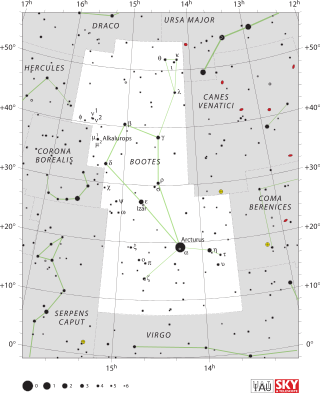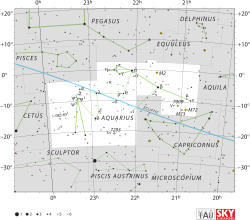
59 Sagittarii is a single star in the southern constellation of Sagittarius, about a degree to the south of Omega Sagittarii near the constellation border with Capricornus. It has the Bayer designation b Sagittarii, or sometimes b1 Sagittarii, while 59 Sagittarii is the Flamsteed designation. The star is visible to the naked eye as a faint, orange-hued star with an apparent visual magnitude of 4.544. It forms the southeast corner of the asterism called the Terebellum. Based upon parallax measurements, the star is located approximately 830 light years away from the Sun. It is moving closer to the Earth with a heliocentric radial velocity of −16 km/s.

98 Aquarii is a star in the equatorial constellation of Aquarius. 98 Aquarii is the Flamsteed designation, although it also bears the Bayer designation b1 Aquarii. It is visible to the naked eye with an apparent visual magnitude of +3.97. The distance to this star, 163 light-years, is known from parallax measurements made with the Hipparcos spacecraft.

91 Aquarii is the Flamsteed designation for a triple star system in the equatorial constellation of Aquarius. It also bears the Bayer designation Psi1 Aquarii. It is visible to the naked eye with an apparent visual magnitude of +4.248. Parallax measurements yield an estimated distance of around 150 light-years from Earth. An extrasolar planet is known to orbit the main star.

99 Aquarii is a star in the equatorial constellation of Aquarius. 99 Aquarii is the Flamsteed designation, although it also bears the Bayer designation b2 Aquarii. It is visible to the naked eye with an apparent visual magnitude of 4.38; according to the Bortle Dark-Sky Scale this is bright enough to be seen even from city skies under ideal viewing conditions. Based upon parallax measurements, the distance to this star is around 283 light-years.

86 Aquarii is a binary star system in the equatorial constellation of Aquarius. 86 Aquarii is the Flamsteed designation, though it also bears the Bayer designation c1 Aquarii. It is faint but visible to the naked eye with an apparent visual magnitude of +4.47. Based upon parallax measurements, the distance to this star is about 220 light-years.
104 Aquarii (abbreviated 104 Aqr) is a star in the equatorial constellation of Aquarius. 104 Aquarii is the Flamsteed designation, although it also bears the Bayer designation A2 Aquarii. Based on an annual parallax shift of only 3.89 ± 0.25 milliarcseconds, the distance to this star is about 840 light-years (260 parsecs). At that range, the brightness of the star in the V-band is reduced by 0.10 magnitudes as a result of extinction caused by intervening gas and dust.

25 Aquarii is a single star in the equatorial constellation of Aquarius. 25 Aquarii is the modern Flamsteed designation; in the past it held the designation 6 Pegasi. It also bears the Bayer designation of d Aquarii. It is located near the border with the modern Pegasus constellation. Although faint at an apparent visual magnitude of +5.09, it is bright enough to be viewed from suburban skies. Based upon an annual parallax shift of 0.01440 arcseconds, it is located at a distance of around 226 light-years from Earth. The visual magnitude of the star is diminished by 0.09 from extinction caused by intervening gas and dust.
68 Aquarii is a single star located 270 light years away from the Sun in the zodiac constellation of Aquarius. 68 Aquarii is its Flamsteed designation, though it also bears the Bayer designation of g2 Aquarii. It is visible to the naked eye as a dim, yellow-hued star with an apparent visual magnitude of 5.24. The object is moving further from the Earth with a heliocentric radial velocity of +24.5 km/s.
41 Aquarii is a double star in the equatorial constellation of Aquarius. 41 Aquarii is its Flamsteed designation. It is visible to the naked eye as a dim, orange-hued point of light with a combined apparent visual magnitude of 5.354. The pair are located at a distance of around 239 light-years from the Sun based on parallax, but are drifting closer with a radial velocity of –25 km/s.
42 Aquarii is a single star located 447 light years away from the Sun in the zodiac constellation of Aquarius. 42 Aquarii is its Flamsteed designation. It is visible to the naked eye as a faint, orange-hued star with an apparent visual magnitude of 5.34. This object is moving further from the Sun with a heliocentric radial velocity of around +13 km/s.
103 Aquarii is a single star in the equatorial constellation of Aquarius. 103 Aquarii is the Flamsteed designation, although it also bears the Bayer designation A1 Aquarii. It is faint but visible to the naked eye as an orange hued star with an apparent visual magnitude of 5.34. Based upon an annual parallax shift of 4.69 mas, the distance to this star is around 700 light-years (210 parsecs). It is moving away from the Earth with a heliocentric radial velocity of +25 km/s.
21 Aquarii is a single star in the zodiac constellation of Aquarius. 21 Aquarii is the Flamsteed designation. It is visible to the naked eye as a dim, orange-hued star with an apparent visual magnitude of 5.49. This object is a member of the HR 1614 moving group, and is moving closer to the Earth with a heliocentric radial velocity of −24.5 km/s.
7 Aquarii, abbreviated 7 Aqr, is a binary star system in the zodiac constellation of Aquarius. 7 Aquarii is the Flamsteed designation. It is visible to the naked eye with an apparent visual magnitude of 5.5; the brighter component is baseline magnitude 5.62 while the faint secondary is magnitude 11.4. As of 2002, the pair had an angular separation of 2.10″ along a position angle of 165°. The distance to this system, based upon an annual parallax shift of 4.9 mas, is around 660 light years. It is moving closer to the Earth with a heliocentric radial velocity of −32 km/s.
77 Aquarii is a single star located 135 light years away from the Sun in the equatorial constellation of Aquarius. 77 Aquarii is its Flamsteed designation. It is visible to the naked eye as a dim star with a baseline apparent visual magnitude of 5.55. The star is moving closer to the Earth with a heliocentric radial velocity of −35 km/s.
5 Aquarii is a single star in the zodiac constellation of Aquarius, located about 830 light years away from the Sun, based on parallax. 5 Aquarii is the Flamsteed designation. It is visible to the naked eye as a faint, blue-white hued star with an apparent visual magnitude of 5.55. This object is moving closer to the Earth with a heliocentric radial velocity of −3 km/s.
30 Aquarii is a single star located about 301 light years away from the Sun in the zodiac constellation of Aquarius. 30 Aquarii is its Flamsteed designation. It is visible to the naked eye as a dim, orange-hued star with an apparent visual magnitude of 5.56. The star is moving further from the Earth with a heliocentric radial velocity of 40 km/s.
26 Aquarii is a single star located approximately 960 light years away from the Sun in the zodiac constellation of Aquarius. 26 Aquarii is the Flamsteed designation. It is visible to the naked eye as a dim, orange-hued star with an apparent visual magnitude of 5.66. This object is moving away from the Earth with a heliocentric radial velocity of +8 km/s.
44 Aquarii is a single star located 336 light years away from the Sun in the equatorial constellation of Aquarius. 44 Aquarii is its Flamsteed designation. It is visible to the naked eye as a dim, yellow-hued star with an apparent visual magnitude of 5.75. This body is moving away from the Earth with a heliocentric radial velocity of +7.4 km/s.

Rho Boötis, Latinised from ρ Boötis, is a single, orange-hued star in the northern constellation of Boötes. It is visible to the naked eye with an apparent visual magnitude of 3.59. Based upon parallax measurements, it is located at a distance of approximately 160 light-years from Earth. It is moving toward the Sun with a radial velocity of −13.6 km/s. There is an optical companion, a magnitude 11.5 star, located 34.7 arcseconds away along a position angle of 345°.
28 Aquarii is a single star located about 560 light years away from the Sun in the zodiac constellation of Aquarius. 28 Aquarii is the Flamsteed designation. It is visible to the naked eye as a dim, orange-hued star with an apparent visual magnitude of 5.6. This object is moving further from the Earth with a heliocentric radial velocity of +8.1 km/s.




